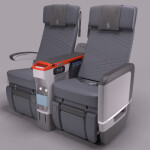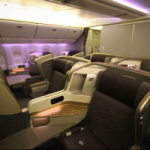Every day across the world there are approximately 50,000 commercial airborne flights, and over a year these flights carry around 3 billion people. While it is obviously very common place now, the miracle of flight, and our ability to cross vast oceans over minutes and hours rather than weeks or months, is something that is not actually very old as far as the history of civilisation goes. Along with the magic of flight, there is also a plethora of other amazing facts that can blow your mind. Read on for five cool pieces of travel trivia.
According to plane manufacturer Airbus, the world’s largest commercial airliner is currently their Airbus A380. Introduced in 2007, this monstrous machine has a range of 15,700 kilometres; a main deck and an upper deck; and can typically seat 525 passengers in three classes, or 853 in a single-class configuration. The plane provides 50 per cent more floor surface than any other similar aircraft and creates less emissions, less noise and less congestion at airports. It has the lowest fuel consumption level per seat out of all planes currently produced and is leading the way in eco-efficient design.
1 / You might be amazed to know that all international airline pilots must now be able to speak English. No matter which airline and which destination you choose, your pilot will be English-speaking! The changes were introduced and made compulsory in 2008 by the International Civil Aviation Organisation (ICAO), in a bid to improve world-wide flight safety standards – studies showed that hundreds of lives had been lost in plane crashes over the years that might have been avoided had there been no communication problems.
2/ It’s a part of flying that you probably take for granted, but there’s actually a valid reason why the lights in an aeroplane cabin are dimmed for take-off and landing. Air Canada’s Service Director, Alice Theriault, explains “The purpose of dimming lights for take-off and landing is to ensure the cabin environment matches the exterior environment. This is done in preparation for a potential evacuation at dusk or at night. Going from a bright lit cabin environment to one that’s pitch black would require some time for our eyes to focus and see the evacuation slide. Since we need to have all the seconds on our side in the event of an emergency, dimming the lights is one of many steps we take to ensure the safety of our customers”. So next time you sigh with frustration when the lights dim just as you’re up to the best part of your novel, remember that there is a very valid, and safety-conscious reason, for the sudden change in lighting level!
3/ Did you know that, according to a senior engineer at Lightning Technologies in the United States, it’s estimated that every commercial plane in the country is struck by lightning on average more than once per year? In a story published in Scientific American magazine, engineer Edward J. Rupke states that many aircraft actually even trigger lightning when they fly through a heavily-charged region of a cloud! However, don’t be alarmed, because since research has been undertaken into how the strikes can affect planes, the protection techniques used in manufacturing have improved dramatically. These days all aircraft must receive a rigorous set of certification tests to verify the safety of their designs.
4/ Even though hearing about a plane crash can send chills up your spine, flying is still actually the safest form of transport in the world. According to a study released by the Department of Transportation in the United States, when comparing annual fatalities from major forms of travel, flying consistently ranks as having the lowest number of deaths. The National Safety Council in the United States found that Americans are actually far more likely to die in a car accident than any other form of transport, such as bus, train or plane. Good news for those who fly a lot, although not so great for people who have a daily car commute!
5/ Have you ever heard the saying that you get drunker when you drink in the air than on the ground? Well technically, that’s not true because blood alcohol levels remain the same whether up in the air or firmly on the ground. What could be the explanation is that you feel drunker because of lower oxygen levels and the pressurised cabin. But the best policy would probably be to not drink, considering what it might feel like being nauseous at over 30,000 feet.
Courtesy Fiji Airways










